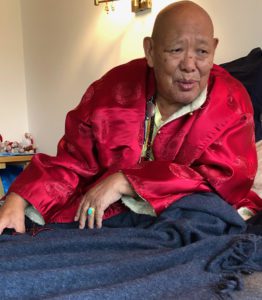Lama Tsultrim Allione’s Recognition
In May of 2007, Lama Tsultrim led a group pilgrimage to Nepal and Tibet to visit the sacred places of Machig Labdrön. Thirty-two people from Europe and United States traveled together, starting in Nepal. The journey felt like a continuous initiation rather than a journey. The high point of the trip occurred at Zangri Khamar, Tibet, where Machig Labdrön lived from ages 37 to 99, and passed away.
Not surprisingly, Zangri Khamar is where we felt the connection to Machig most strongly. We arrived at Zangri Khamar on June 2nd, just after the full moon of Saga Dawa, the most sacred month of the Tibetan year. Zangri Khamar sits on a small hill above the Tsangpo River.

Our group at the Gompa at Zangri Khamar with the resident Lama(Photo by Jérôme Edou)
The monastery is surrounded on all sides by stark, dry mountains, in great contrast to the green valley of barley fields directly below, and the aqua-colored Tsangpo River just beyond. As soon as we arrived, the place felt like home. The resident Lama came out to meet us with incense and lead us into the temple. We found out later that he had had a dream in which he saw a white Dakini coming from the West sounding a damaru loudly, so he had been expected us. He led us to the Gompa (monastery) where he insisted Lama Tsultrim sit on the throne. The monastery was built around Machig’s cave. There were many rooms where we camped out and the beautiful Gompa where we were all able to practice the Chöd together.
The resident Lama was recognized by the 16th Karmapa, Rangjung Rigpe Dorje as the seventh incarnation of the brother of the Eighth Karmapa, Mikyo Dorje. The 16th Karmapa named him Karma Nyitön Kunkhyab Chökyi Dorje. That afternoon he asked Lama Tsultrim to teach and she gave a teaching from “The Final Words of Machig Labdrön” from Jérôme Edou’s book, Machig and the Foundations of Chöd. It was transformative for all of us as these original teachings had actually been spoken by Machig at this very place and Jérôme, who was there with us, had translated them from Tibetan to English and was now translating them from English to Tibetan for Rinpoche. The next day, in the morning, Rinpoche and a resident yogini brought fresh milk to Lama Tsultrim at dawn, an auspicious gift. Then Rinpoche gave a teaching on the Jigme Lingpa form of Chöd known as the “Bellowing Laughter of the Dakinis.” During this teaching, Rinpoche again insisted Lama Tsultrim take the throne while he sat on a lower seat.
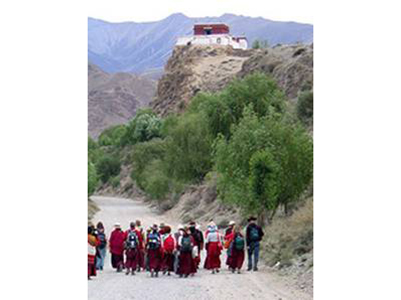

On the way to the Tsangpo River to do Chöd, Zangri Gompa above (Photo Anne and Barry Patterson)
There were rainbows several times during that day and at one point a double rainbow around the sun appeared and, to our delight, stayed for several hours. That afternoon we all went below to the river, which is quite wide, stretching a kilometer across. On the sandy banks, Rinpoche performed the Chöd dance at the water burial site. We all sat on the beach in a semi-circle to watch this ancient, sacred spectacle. During his dance dark clouds gathered as the wind picked up and the dramatic late afternoon light filtered through. Then we all did Chöd with him. As soon as we began, it started to sprinkle, slowly at first, and then it poured. We kept going. At the end, we were soaked to the skin and laughing in the wild wind.
The rain had just stopped as we finished the Chöd and Rinpoche said, “This rain is very auspicious. There has been a four-month drought during our growing season. This is the final sign I was waiting for. At this time I want to make it clear to all of you, and there should be no doubt, that Tsultrim is an emanation of Machig Labdrön.” To me, this felt so obvious. Of course Tsultrim is an emanation of Machig! It was a simple fact like saying that the river is turquoise-colored or that it had been raining. It was a statement that seemed so straightforward, yet with such profound consequences. After a few moments, we got up and Rinpoche began teaching us the Chöd dance, followed by wild dakini dancing on the beach.
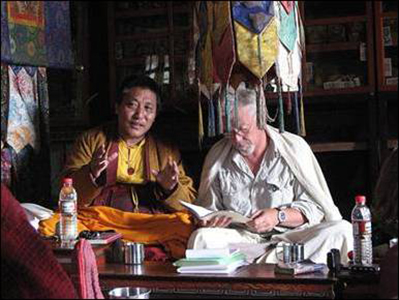

Jérôme Edou translating for Rinpoche (Photo by Petra Sloan)
The next day, Rinpoche offered Lama Tsultrim a self-arisen golden crystal phurba (ceremonial dagger from Zangri Khamar), the only remaining tsa tsa made from the ashes of Machig’s body (a mixture of clay and ash imprinted with an image of Machig dancing), texts of Machig’s teachings, a hat with symbolic meaning designed by Machig, and various other treasures. These gifts had great significance, because in all his lifetimes, the Rinpoche has been devoted to the teachings of Machig, and he was the resident lama at Machig’s seat. When Lama Tsultrim suggested the relics be kept at Zangri, the Lama said he had seen many so many relics thrown into the TsangpoRiver by the Chinese and that the future of the lineage was in America.
When we left the monastery for the final time, Rinpoche created a processional walk, leading Lama Tsultrim with incense and an incredibly heart-felt song, which was like a lamentation. He led her onto the bus where he sat her down and sang another song. Many of us were crying as he was praying for her long life and rapid return. Then, Rinpoche offered Chang from the kapala (skullcup) to everyone on the bus. Locals also appeared wanting blessings from Lama Tsultrim. Then suddenly we were on our way and looking back at the red monastery on the hill in the distance.
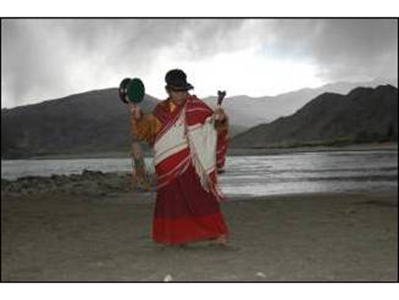

Rinpoche performing the Chöd dance on the beach (Photo by Jérôme Edou)
To those of us on this pilgrimage, it feels like we now have an ever deeper connection to the teachings of Machig and to the place where Machig spent the majority of her life. As we have discussed among ourselves, the awareness of these links and the experience of Lama Tsultrim being recognized as an emanation of Machig has opened energetic doors that will contribute to and deepen Lama Tsultrim’s work in spreading the teachings and transmitting Machig’s lineage.
Besides this experience with the Lama at Zangri, during our stay in Nepal, Lama Tsultrim was also recognized as an emanation of Machig Labdrön by Lama Tshering Wangdu Rinpoche, holder of the lineage of Dampa Sangye. In 2006 she had had a vision of Machig Labdrön riding a white lioness, when this vision was told to Lama Wangdu he said he had had the same vision and that at that time he received predictions that the Chöd lineage would move to America. As soon as we got to Nepal, he began to call her “Machig Labdrönma.” On our return from Tibet, after giving the empowerment of Machig to the group, he said to her privately, “This recognition is important so that the teachings of Machig can flourish and people will have no doubts about who you are.” Wangdu Rinpoche told the Vajracharya (Dorje Loppön) of Shechen Monastery this as well and he related it to me later.
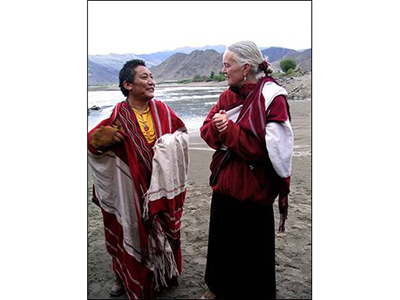

The resident Lama at Zangri Khamar and Lama Tsultrim on the beach after the recognition announcement (photo Barry and Anne Patterson)
About the recognition, Lama Tsultrim recently said, “This explains why I have had a life-long connection with Machig’s teachings beginning in 1973 learning Chöd and the dreams leading to finding her biography in 1981. As we drove away from Zangri Khamar I thought, ‘Why this recognition, why now, what is the purpose?’ I think it is to make this new phase of collecting Machig’s lineage more empowered, I see it as I am working for Machig. Recognition allows more energy to flow, and Machig’s blessings can manifest more fully. It’s a kind of mirroring from the outside, validating our heartfelt intention to reinvigorate and spread Machig’s lineage in the West. We will keep doing what we have been doing already, but the recognition creates an auspicious interdependence for the teachings.”
Before she passed away at Zangri Khamar, Machig said:
For ninety-nine years, I have worked for the benefit of beings.
Now this work is complete.
I will not take birth again in this human realm in a physical form,
Nor will I leave behind any relics.
But my emanations in the world will be innumerable;
And many will recognize them.
They will be perceived in different ways,
Depending on karma, pure or impure.
Once a being reaches enlightenment they are no longer subject to the limitation of one body and may emanate into many different dimensions and forms. An emanation continues the work of the original incarnation. May you all feel the radiance and blessings of this event!
Emaho!
Written by Lopön Beth Lee Herbert
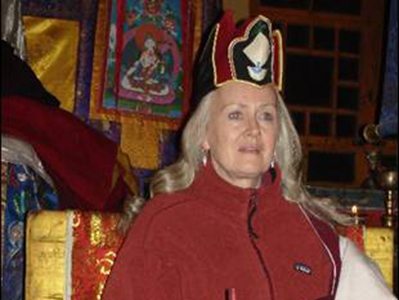

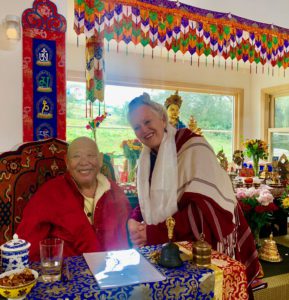

In 2007 in Nepal, Lama Tsultrim was recognized as an emanation of Machig Labdrön at Machig’s main monastery Zangri Khamar, by the resident Lama. Before Lama Tsultrim went into retreat February 19, 2019, she had the blessing of meeting Lama Tshering Wangdu Rinpoche again. In these videos, you can witness Lama Tshering Wangdu Rinpoche reading the formal recognition letter.
